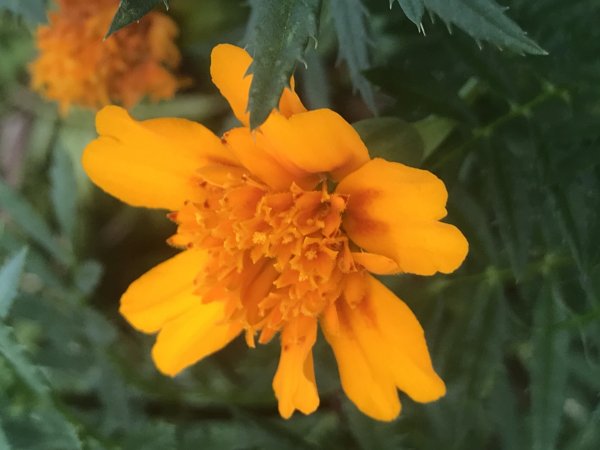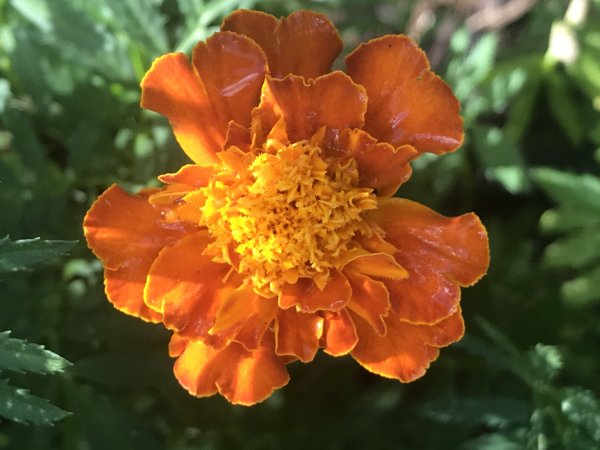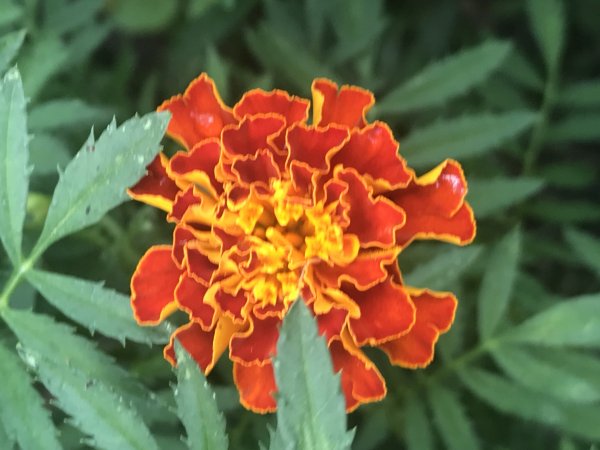Southern gardens are plagued by insect pests and harsh growing conditions. And even in other parts of the country, gardeners are looking for more natural and sustainable ways to deter pests and disease without the use of synthetic and dangerous chemicals. Enter companion planting, and enter one of the more famous flowers used for this technique: French Marigold benefits the garden in numerous ways.
Companion Planting
If you’ve been gardening in the 21st century for more than a couple of weeks, you’ve heard of companion planting. In short, this is the practice of planting mutually beneficial plants together in one space to support each other. It can also be the planting of herbs and flowers near vegetable plants that will support those vegetables in some way.
Complicated Combinations
One of my chief complaints about the practice of companion planting is that it can involve complicated combinations of herbs, flowers, and edibles. While I would love to go into a deep dive on the science of each, that will have to wait for next summer during the down season.
The subject of what to plant together and what not to plant can become mind-boggling. Add in a rotation schedule and you’ve got all the makings of a migraine.
I’m lazy and I like my gardening simplified. I plant diversely and densely and let nature sort it out. I like to think that if I have the basic makings of biodiversity and support my soil microbiology, it will all come out the way nature intends in the long run — even if I don’t’ get what I want in the short run.
This drives my family crazy because the ones that like to cook (or feed the rabbits from the garden) end up wandering around the whole yard trying for find what they’re looking for. No, I don’t have endless patience for labels. And no, I don’t plant all the same plants in one area so they’re easy to find and harvest.
That’s intentional. I figure that if my stepson can’t find the Pak Choy, then the slugs will also have some trouble finding it. The same goes with beans and aphids and cabbage and cabbage loopers.
We’re supposed to be the species with the big brains and the ability to generalize, after all.

Steady Go-To Companions
However, one thing I definitely do is to plant flowers (and sometimes herbs — I have trouble with herbs) within ALL of my vegetable garden beds. Flowers attract pollinators and predator insects that hunt down those cabbage loopers and aphids.
If I was to offer any recommendations to new gardeners in any zone, the first would be to plant seasonal annual flowers within EVERY single fruit and vegetable planting.
French Marigold Benefits
French marigold (Tagetes patula) has a reputation as the wunderkind of companion plants. Most of that reputation is well deserved and well documented.
Along with being available in a number of varieties for various applications, they’re also very attractive, with bushy foliage and bright, cheerful blooms. Best of all, they’re incredibly easy to grow and maintain.
I’ve grown French marigolds in both Central Ohio and Central Florida, and both times I’ve been impressed by their dogged resilience.
Pest Repellants
In short, French Marigold benefits include deterring root-knot nematodes, the bane of the Florida gardener’s existence. They’re also said to deter slugs and hornworms.
I can tell you from experience that they do NOT deter snails. Snails LOVE French marigolds. In fact, they make serve as an excellent trap crop for snails. I regularly find snails clinging to my French marigolds. I break the stem and carry it, snail and all, to my chicken yard.
Chickens LOVE snails. And they also like marigolds.

Methods to the Madness
It seems that French marigolds repel pests using different mechanisms, depending on the pest. Volatile chemicals in the foliage and flowers that give them their distinctive odor can sometimes confuse insects that seek their target plants through smell. Other insects may simply find the odor repulsive and unpleasant.
Another mechanism is through root exudates. Plants emit various elements through their roots in order to attract beneficial bacteria to trade nutrients. These elements include sugars, which the bacteria adore, and offer micronutrients and macronutrients in exchange with the plants.
And by no means the last method, some French marigold benefits include using the flower as a trap crop, as I mentioned above regarding snails. In fact, in the case of root-knot nematodes, there is some debate as to whether marigolds repel them through root exudates or simply attract them to themselves, thereby “trapping” them in their own roots.
White Fly Results
A 2019 study examined the theory that French marigolds will reduce whitefly populations in tomatoes. I’ve never found them on tomatoes, but my peppers always seem to attract a crowd.
A few experiments found that planting French marigolds alongside tomatoes reduced the whitefly population in the greenhouse. In this case, it was the volatile compound, limonene, these flowers produce that repelled the pests.
Root Knot Nematodes
Root-knot nematodes can completely destroy a once-thriving garden. And it seems that Southern gardens are particularly rife with this soil pest. I remember moving to Florida as an experienced temperate zone gardener in 1993 and being warned that they were public enemy number one.
The UF/IFAS website recommends French marigolds as a cover crop before planting. It posits that the action of alpha-terthienyl, a root exudate, inhibits the hatching of many nematode eggs. It also suggests planting them at least two months prior to your crop, and disking or hoeing them in is the most effective method. The site says interplanting isn’t particularly effective.
In my case, I grow year-round and successively. I don’t do cover crops on beds in production, so using marigolds this way wouldn’t work for me. Especially since I do no-till.
So, I simply interplant several marigold “crops” throughout the year and then crop and drop them on top of the soil at the beginning of each season. At the same time, I plant more marigolds throughout the beds.
I harvest seeds and plant them again later. I even sell them in my Etsy shop for very little profit so other gardeners can be sure they have the right type of marigolds.
As I vaguely recall, the action of nematode suppression in marigolds extends to about a meter, or three feet in diameter, so I make sure that I have at least one planted every yard or so, staggered throughout the beds.

Medicinal Uses
Because of its rich components of chemical constituents, French marigolds have a number of traditional medicinal and cosmetic uses, many of which could translate well today.
A 2016 paper suggests that the blossoms, containing the flavonoids patuletin, quercetagetin, and quercetin, help protect against oxidative stress and offer anticancer properties when used in an infusion (i.e., tea).
I’m not a doctor and don’t intend to play one on the internet, so make sure you do all your due diligence before compounding your own herbal medicinals. Some are harmless, some are effective, and some can prove quite dangerous.
It’s important to remember that there are two different species of flowers we call “marigold,” with French marigold being “Tagetes” variety. There is also Calendula officinalis, also known as “Pot marigold,” which is used extensively in cosmetics.
Fortunately, while the common name is very similar, the two plants don’t resemble each other and have very different appearances.

Beauty and Function
Tagetes patula, French marigolds, offer a host of garden benefits. However, perhaps their most important quality is the beauty they add to the garden. Even if you’re immune to the superficial beauty of flowers, any dedicated gardener has to admit that the practical beauty of an increase in bee visitors is a spectacle to behold.